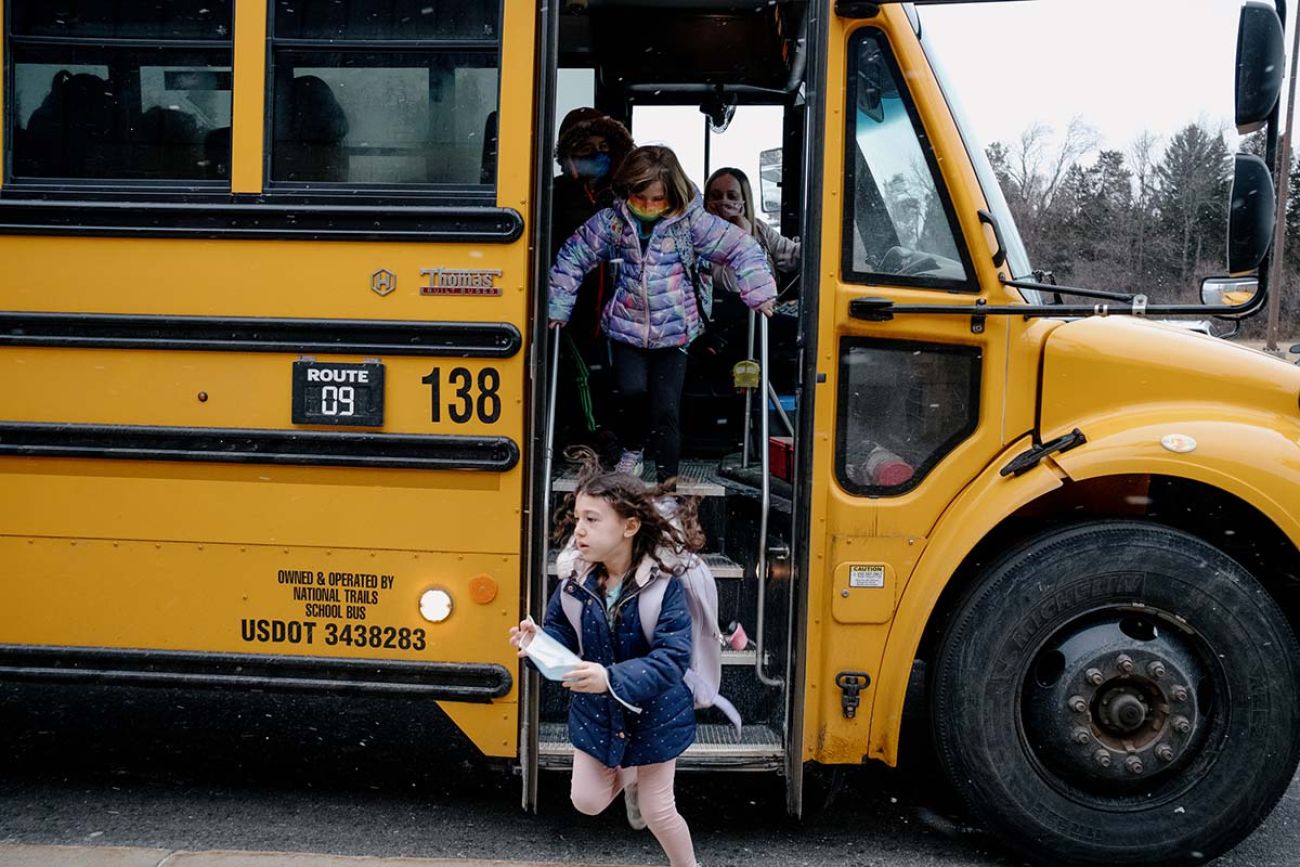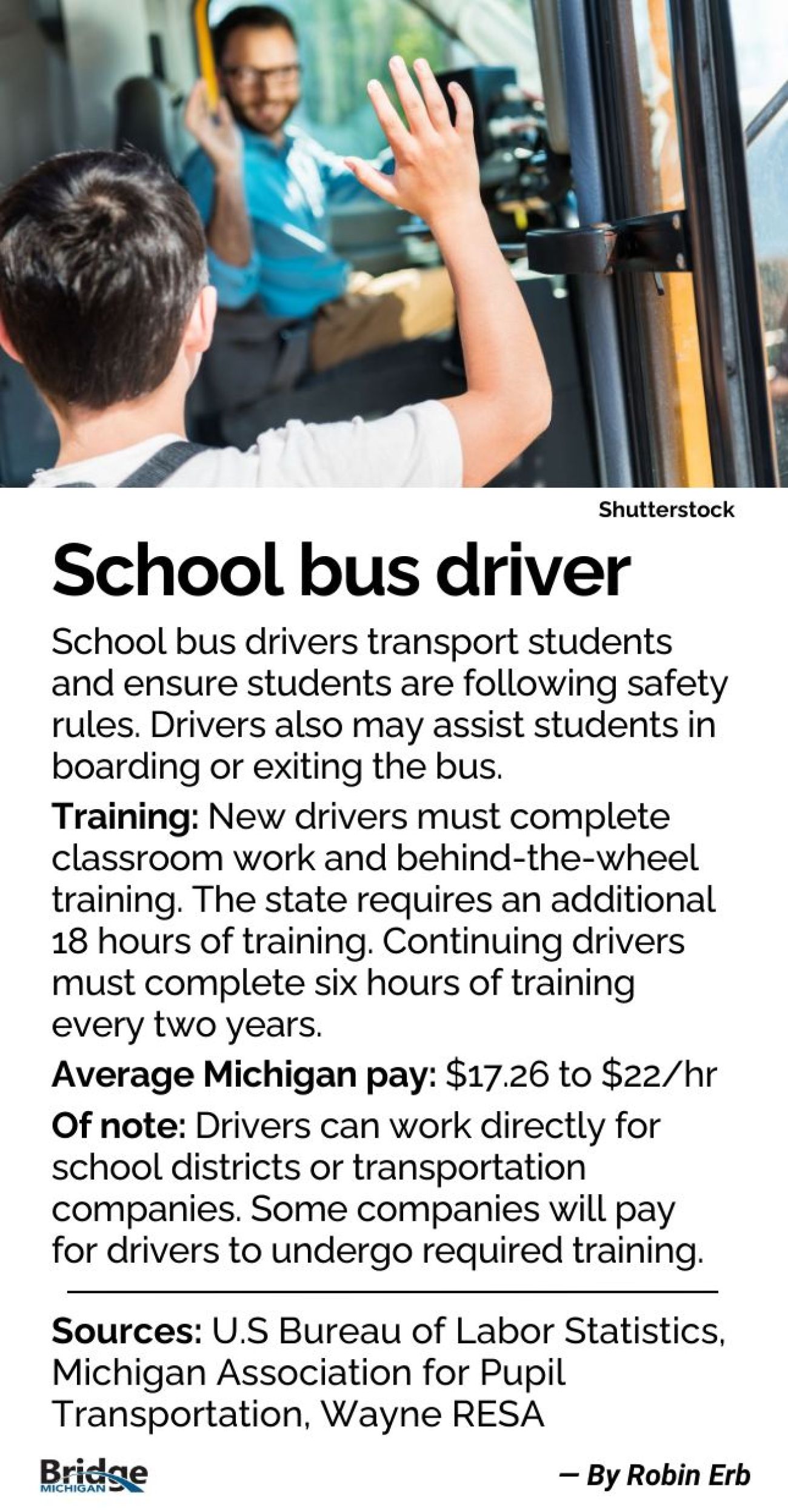How Michigan schools are trying to attract 1,000 or more new bus drivers

- School districts say they need more school bus drivers, but job seekers now have more options than a few years ago
- New school bus drivers must undergo rigorous training mandated by the state and federal government
- Even with an influx of more money in the education budget, bus driver training and salaries remain a hurdle
Michigan school districts are getting creative with how to get students to school even when there aren’t enough school bus drivers to drive big yellow buses.
In Lansing, the district is giving out gas cards and public transportation passes. In the Detroit area, some districts are contracting with a ridesharing company to supplement traditional busing. And across Michigan, school transportation supervisors hop into the driver seat to fill in when needed.
“A kid in a classroom is probably going to learn a lot more than a kid on his couch,” said Lansing School District Superintendent Ben Shuldiner of the need to get students to school.
Related:
- Wine apprenticeships? Michigan’s worker shortage makes businesses get creative
- In Michigan mental health crisis, a tug-of-war over too few social workers
- Lack of school counselors hobbles Michigan college enrollment efforts
School districts across the country have struggled with not having enough drivers for several years. There was “at least one instance of a major school bus driver shortage in every state this year,” USA Today reported in August.
In a survey of 46 out of the 56 intermediate school districts in Michigan, more than half of the ISDs call bus drivers a critical shortage area. Wayne RESA, the ISD in Wayne County, estimates there are between 13,000 and 15,000 school bus drivers in the state.
How many bus drivers are needed is less clear since districts and transportation companies have wide leeway in determining how many of their students are eligible for busing.
Transportation experts cite a host of reasons for why there aren’t enough drivers. The job requires a lot of training, can be challenging and the pay — roughly $17 to $22 an hour — is not particularly high.
Erik Edoff, superintendent of L’Anse Creuse Public Schools in Macomb County, said bus driving used to be seen as a relatively flexible job: drivers had time off in the middle of their day and they got to work at their local district where their kids went. Now, there are many jobs that offer more flexibility, including the ability to work remotely and set your own hours.
“There’s just so many alternatives that offer greater flexibility,” he said. “And every industry is paying more money than they used to because of the labor situation.”
As Bridge Michigan has been reporting this year, many critical industries in the state are struggling to find trained employees, with job vacancies for everything from social workers to police officers, child care providers and medical assistants.
Mac Dashney, a school transportation consultant in Lansing with over 50 years experience, told Bridge that 1,000 to 1,500 more bus drivers would be a huge step in helping districts meet students’ transportation needs.
But, he cautioned, that number is a moving target as busing needs change. For example, districts also provide busing during the school day for high school students who take some classes at a local community college or regional career technical site.
Dashney estimates it costs districts between $1,500 to $2,000 to train a new driver.
School transportation costs vary widely among school districts, and can be particularly high for sparsely populated rural districts, which cover a larger geographic area. Rural districts pay an average of $200 more per student for transportation, as Bridge previously reported. The higher the transportation costs, the less money available for classrooms.
Sarah Winchell Lenhoff, an associate professor of education at Wayne State University who studies school transportation in Detroit, said national research shows the link between school transportation and attendance (Detroit has among the highest rates of chronic absenteeism in the nation), which in turn affects student test scores and graduation rates.
Lansing School District contracts with Dean Transportation for buses and drivers, whose website currently shows a slew of open driver positions, with sign-on bonuses up to $750 and pay up to $22 an hour.
Shuldiner, the superintendent, said that a few years ago the district had 72 buses that each ran three routes in the morning and the afternoon.
Now, the district contracts for 41 buses with most doing two routes each in the morning and in the afternoon.
High school students do not have the option to ride a yellow school bus, a decision made last school year.

But the district does provide an unlimited ride pass for public transportation or a $50-a-month gas card to help high school students. Younger students are eligible for a bus pass, gas card or yellow bus.
He said the shortage of bus drivers was a factor in offering students public transportation, but said he also believed the public option is better.
“And what I mean by that is if you miss the school bus, you might not go to school. If you miss the public bus, there’s always another one.”
Shuldiner said high school attendance rates are higher compared to pre-pandemic rates.
In the current school year, 2,655 Lansing students have chosen gas cards, 870 students have public transportation passes and 3,360 students are on Dean buses. (The figures don’t include special education students who receive transportation through a different contract through the local ISD.)
Almost 30 percent of Michigan school districts contract with private companies for transportation services, according to a 2022 study by the Mackinac Center for Public Policy.
In metro Detroit, some districts contract with HopSkipDrive, a ridesharing company that supplements traditional bus routes. Students are driven by a “caredriver,” an adult who has passed a background check and has caregiving experience.
Joanna McFarland, co-founder and CEO of HopSkipDrive, told Bridge the company has contracts with “nearly a quarter of the school districts in the Detroit area as well as a number of charter schools.”

HopSkipDrive recently launched a software program designed to help districts use data to “minimize the impact of bus driver shortages,” according to a company announcement.
McFarland said school bus routes are often based on student eligibility for bus transportation rather than on which students actually use the bus.
“If you put those kids into sedans, and move those bus drivers to routes where they're really needed, you can better serve the entire system,” McFarland said. “And we've been able to help a lot of school districts solve their driver shortages in many ways.
“And what they find is they don't actually have a driver shortage. They're just doing things in a way that is inefficient given the actual ridership.”
Lenhoff, the Wayne State researcher, said there is little information on school bus ridership in Detroit. Without that information, she said, it’s hard to determine what are the most cost effective choices in transportation. Plus, she said, there is not great national data on what type of transportations families use to get their students to school.
Policy changes could help shortage
Katrina Morris, executive director of the Michigan Association for Pupil Transportation and transportation director at West Shore ESD, an intermediate district in northwest lower Michigan, said she is optimistic a series of policy changes recently adopted will help the school districts attract more drivers.
Gov. Gretchen Whitmer recently signed legislation that allows school districts to use their sinking funds — savings accounts made up of local tax funds — to help cover school transportation costs.
The new state education budget includes $125 million to help offset transportation costs for districts. Morris said this new model will help schools spend their state per pupil funding on classroom initiatives rather than on the costs of fuel, bus repairs and driver pay.
Shuldiner, the Lansing superintendent, said higher pay for drivers will also help. And he suggested making them full-time school employees with benefits, which would make them available to take on other school jobs during the day when they are not driving.
Morris’s West Shore district has 18 buses and 11 routes. She has 12 drivers and three substitute drivers, including one she hired a week after Whitmer signed a law that allows recent public school retirees to come back to work without having to forgo their pension benefits.
Providing training for new and experienced drivers
New drivers must go through serious training before taking the wheel.
“A school bus driver with a commercial license is a pretty rigorous training and I don’t think many people realize what is required for a school bus driver,” said Kelli Schultz, transportation consultant for Wayne RESA.

Trainees must first pass a state test to receive a commercial learner’s permit. There is also behind-the-wheel training on parallel parking, railroad crossings, student pickups and right turns. It takes trainees three to six weeks to complete that and another four hours to complete a theory portion of training.
Then, drivers must still go through a minimum of 18 hours of state-mandated training, pass a physical exam, drug tests and undergo fingerprinting. Once hired, they must complete six hours of training every two years.
“It is a long process and pretty rigorous,” Schultz said.
Wayne RESA tried to reduce one barrier to entry by offering a free, four-hour, online course on theory training. Since launching last year, 91.5 percent of those who registered completed the training.
Schultz recommends people interested in becoming drivers go to a school district or a transportation services company so they will pay for the driver’s training.
Tom Korth, transportation supervisor at Oakland Schools and president of the Training Agency Association of Michigan, said those who complete training will reap rewards that go beyond a paycheck.
He said drivers can help make school a positive experience for students. Korth is running a training series for current drivers on communications skills, including how to build relationships, understand different perspectives and develop common ground. The goal is to help drivers feel valued and improve communication between drivers and students, parents and administrators.
“I want them to be known as an integral member of the education team in affecting positive student outcomes.”
Michigan workers vacancies
In this occasional series, we examine the scope of critical worker shortages in 2023, from doctors and police officers to math teachers and social workers. To view more stories in this series click here.
Michigan Education Watch
Michigan Education Watch is made possible by generous financial support from:
Subscribe to Michigan Health Watch
See what new members are saying about why they donated to Bridge Michigan:
- “In order for this information to be accurate and unbiased it must be underwritten by its readers, not by special interests.” - Larry S.
- “Not many other media sources report on the topics Bridge does.” - Susan B.
- “Your journalism is outstanding and rare these days.” - Mark S.
If you want to ensure the future of nonpartisan, nonprofit Michigan journalism, please become a member today. You, too, will be asked why you donated and maybe we'll feature your quote next time!





